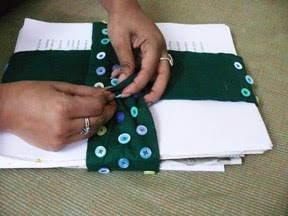Sunday, September 13, 2009
Course critic
Final Products
Research & experimentation:
We explored the various possibilities that could be taken into consideration when working with the skills of Krishnaveni aunty. We looked into various subjects where her stitching and painting skills could be put to use. We also looked at other simple things that she could do alongside that could broaden her range of work.
1) paper cutting
2) stitching buttons
3) braiding, weaving, knotting
4) mirror work, embroidery

Product/ prototype making:
We made small samples and prototypes of the objects we hoped to build on. Since some of them were big products that required a lot of time and resources, we cut it down to a small sample to see if it was worth taking forward.
1) lamp- led cloth, techniques swatch
2) led book
3) binder
4) pencil box/pouch - tetra-pack version, newspaper stripes
5) reusable book cover

Newer products:
To broaden our range, we introduced several different ideas that were simple and could be sold relatively cheaper.
1) cards
2) gift wrapping paper
Brand identity:
We realized the need for creating a brand identity for the products. They were already a little different from the usual products, and by showing that there existed an entire range of such products, it would help in advertising to the customers. It would also help bring all the products under a common name such that although the customers may have to buy the products from the stores, it helps retains their own identity.
We talked to Krishnaveni about our idea and asked for her input. We made sure to do that so that we keep her in the loop and part of the process. Since, in the end, the business venture is to be hers, its important for her to approve our ideas.
Krishnaveni wished to call the business 'Shreya' after her granddaughter. Working on that, we worked on creating an entire brand identity.
We thought about creating either labels or tags that would carry the brand on each product.
Packaging:
Most shops in Yelahanka (which is our primary market at the moment) sell products in plastic bags. That would mean that only a few of our products that cannot do without it would require packaging.
Our initial idea, however, had to do with selling the products in the city too. It would be available to a larger and more cosmopolitan audience who would be willing to shell out more money for the products.
By creating a good brand identity and packaging, we could turn it into an exclusive brand, and in turn increase the price rates.
Packaging is very important in that case.


Marketing, publicity:
Focusing on Yelahanka as our market for the moment, we thought about various ways of publicizing and marketing the products.
1) One of the major factor is location. The location of the advertising, and the location of where the products are kept for sale. We, thus, began looking at the various shops around Yelahanka and their clientele.
2) Publicity also requires some consideration into the location. We thought of publicizing not only at the stores where they are being sold, but also on the packaging bags.
Wednesday, August 19, 2009
A step forward



Brainstorming & Ideas...

Working on my new project brief, I came across the idea of working with people with time to spare. The guards, the people working in shops, and all the others who spent a part of their time idle.

Wednesday, August 12, 2009
Thoughts behind my brief
What are the logistics..? who am I keeping in mind-- who am I designing for?
Who will carry on after I leave?
Where does innovation come in?
What is so special about what I am planning to do that makes me a 'designer'?
What other understanding or knowledge do I have that other people don't have?
What am I contributing?
Is it something that has already be done before?
Keeping these in mind I set out again, to create another brief and work on something new that would work better within the space provided by the course.















